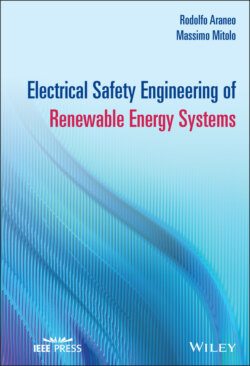Читать книгу Electrical Safety Engineering of Renewable Energy Systems - Rodolfo Araneo - Страница 27
1.11 Measuring Touch Voltages
ОглавлениеMeasurements after construction of the installation can verify the adequacy of the electrical design of the substation [30]. Measuring touch voltages [31–33] includes two choices: measure the prospective touch and step voltages, by using a high-impedance voltmeter, or measure the effective touch and step voltages occurring across an appropriate resistance of 1 kΩ, which represents the human body.
For touch voltage measurements a current injection method may be used (Figure 1.18).
Figure 1.18 Touch voltage measurement with the current injection method.
An alternating voltage of approximately the system frequency is applied between the facility ground electrode and an auxiliary ground electrode, located far enough to guarantee separate zones of influence (e.g., 4 or 5 times the maximum dimension of the facility ground electrode). A test current im is injected into the facility grounding system, which causes a measurable ground potential rise.
The test current should be so high that the measured touch voltage, referred to as the test current, is greater than possible disturbance voltages; according to EN 50522, this may be ensured for test currents of at least 50 A. Always according to EN 50522, the measuring electrodes for the simulation of the feet, connected in parallel, must have a total area of 400 cm2, lie on the ground with a minimum total force of 500 N, and placed at a distance of 1 m from the equipment of the installation, or from an EXCP. During the test, the auxiliary ground electrode may assume a dangerous ground potential rise, and therefore should be guarded.
The tip-electrode for the simulation of the hand touching the equipment, or an EXCP, must be capable of penetrating a paint coating (not insulation).
The reading of the voltmeter, which is referred to as the test current, must then be scaled up by multiplying it by the ratio of the effective ground-fault current provided by the utility to the test current.
The touch voltage measurement should be performed in the substation, as a sampling test, keeping in mind that higher magnitudes for the touch voltages may be found around the edge of the ground grid.
